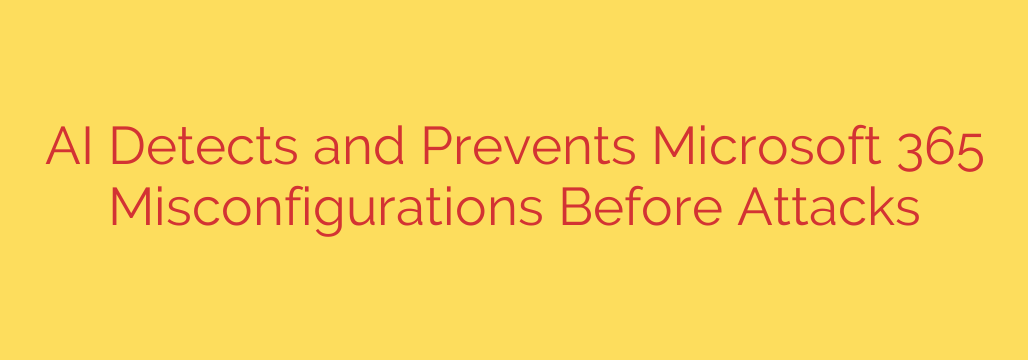
Unseen Threats: How AI Is Your First Line of Defense Against Microsoft 365 Misconfigurations
Microsoft 365 is the backbone of modern business, a powerful suite of tools that drives productivity and collaboration. While Microsoft provides a robust and secure foundation, the ultimate security of your environment rests on its configuration. A single overlooked setting or an unintentional error can create a critical vulnerability, essentially leaving a digital door unlocked for cybercriminals.
The sheer complexity of the Microsoft 365 ecosystem makes manual security audits a monumental task. Settings are vast, interconnected, and constantly evolving. This is where the silent threat of misconfigurations emerges—small, often invisible errors that can lead to catastrophic data breaches. Fortunately, a new paradigm in cybersecurity is shifting the balance of power: Artificial Intelligence is now being used to proactively detect and prevent these misconfigurations before they can be exploited.
The Silent Threat: Understanding Microsoft 365 Misconfigurations
A misconfiguration is any setting that deviates from security best practices, inadvertently increasing your organization’s risk profile. These are not software bugs or flaws in the platform itself; they are human errors in setup and maintenance.
Common examples include:
- Overly Permissive Sharing Settings: Allowing anyone with a link to access sensitive internal documents.
- Disabled Multi-Factor Authentication (MFA): Failing to enable the single most effective defense against credential theft for all users.
- Inactive Account Policies: Leaving the accounts of former employees active, creating orphan entry points for attackers.
- Lax Administrative Privileges: Granting too many users global admin rights, expanding the potential for a high-impact compromise.
Attackers actively hunt for these mistakes. They are the low-hanging fruit that can allow an intruder to bypass traditional defenses and gain a foothold in your network.
Why Manual Security Checks Are No Longer Enough
Relying on periodic, manual audits to secure a dynamic cloud environment like Microsoft 365 is like trying to guard a fortress by only checking the gates once a day. The landscape changes too quickly. An administrator might temporarily change a setting for a valid reason and forget to revert it, instantly creating a new vulnerability.
Manual checks are:
- Time-Consuming: It can take days or weeks for security teams to perform a thorough review.
- Prone to Error: The complexity of M365 means even seasoned experts can miss subtle, interconnected risks.
- A Snapshot in Time: An audit is outdated the moment it’s completed, offering no protection against new changes.
This reactive approach means you’re always one step behind, discovering security gaps only after they’ve been created.
The AI Advantage: Shifting from Reactive to Proactive Security
AI-powered security solutions fundamentally change this dynamic. Instead of relying on periodic spot-checks, AI provides a continuous, intelligent layer of oversight that works around the clock.
Here’s how AI is revolutionizing Microsoft 365 security:
- Continuous, 24/7 Monitoring: An AI system constantly analyzes your M365 tenant’s configuration against established security benchmarks and best practices. It never sleeps and never gets fatigued, ensuring no change goes un-inspected.
- Detection of Complex Risk Patterns: AI excels at identifying vulnerabilities that a human might miss. It can connect the dots between a seemingly harmless setting in SharePoint, a user policy in Azure AD, and an email rule in Exchange Online to flag a sophisticated, multi-stage risk.
- Proactive Alerts and Prioritization: When a misconfiguration is detected, the system can instantly alert security teams with context-rich information. It explains why the setting is a risk and what potential attacks it enables, allowing teams to prioritize the most critical fixes first.
- Adapting to New Threats: As new attack vectors and exploitation techniques emerge, AI models can be rapidly updated. This ensures your defenses evolve alongside the threat landscape, providing protection against zero-day vulnerabilities and novel attack methods.
By automating the detection process, AI frees up security professionals to focus on strategic initiatives rather than getting bogged down in the endless and inefficient cycle of manual audits.
Actionable Steps to Secure Your M365 Environment
While AI offers a powerful solution, foundational security hygiene is still essential. Here are practical steps every organization should take to harden its Microsoft 365 posture:
- Enforce Multi-Factor Authentication (MFA): This is non-negotiable. Ensure MFA is enabled for all users, especially administrators. It is your strongest defense against compromised credentials.
- Implement the Principle of Least Privilege: Users and administrators should only have the minimum level of access required to perform their jobs. Regularly audit and revoke excessive permissions.
- Review and Restrict External Sharing: Define clear policies for what data can be shared externally and with whom. Set default sharing links to be specific to individuals rather than “anyone.”
- Leverage Conditional Access Policies: Use Azure AD Conditional Access to create rules that govern access based on user, location, device health, and risk signals. For example, you can block logins from unmanaged devices or suspicious locations.
- Audit for Dormant Accounts: Regularly identify and disable accounts for users who are no longer with the company to close these potential backdoors.
As businesses deepen their reliance on the cloud, the attack surface expands. Simply trusting default settings is no longer a viable security strategy. The future of protecting your most valuable data lies in a proactive, intelligent approach. By leveraging AI to continuously monitor for and remediate misconfigurations, organizations can finally move from a reactive posture to a state of true cyber resilience, stopping attacks before they ever begin.
Source: https://www.helpnetsecurity.com/2025/08/06/abnormal-ai-updated-security-posture-management/








